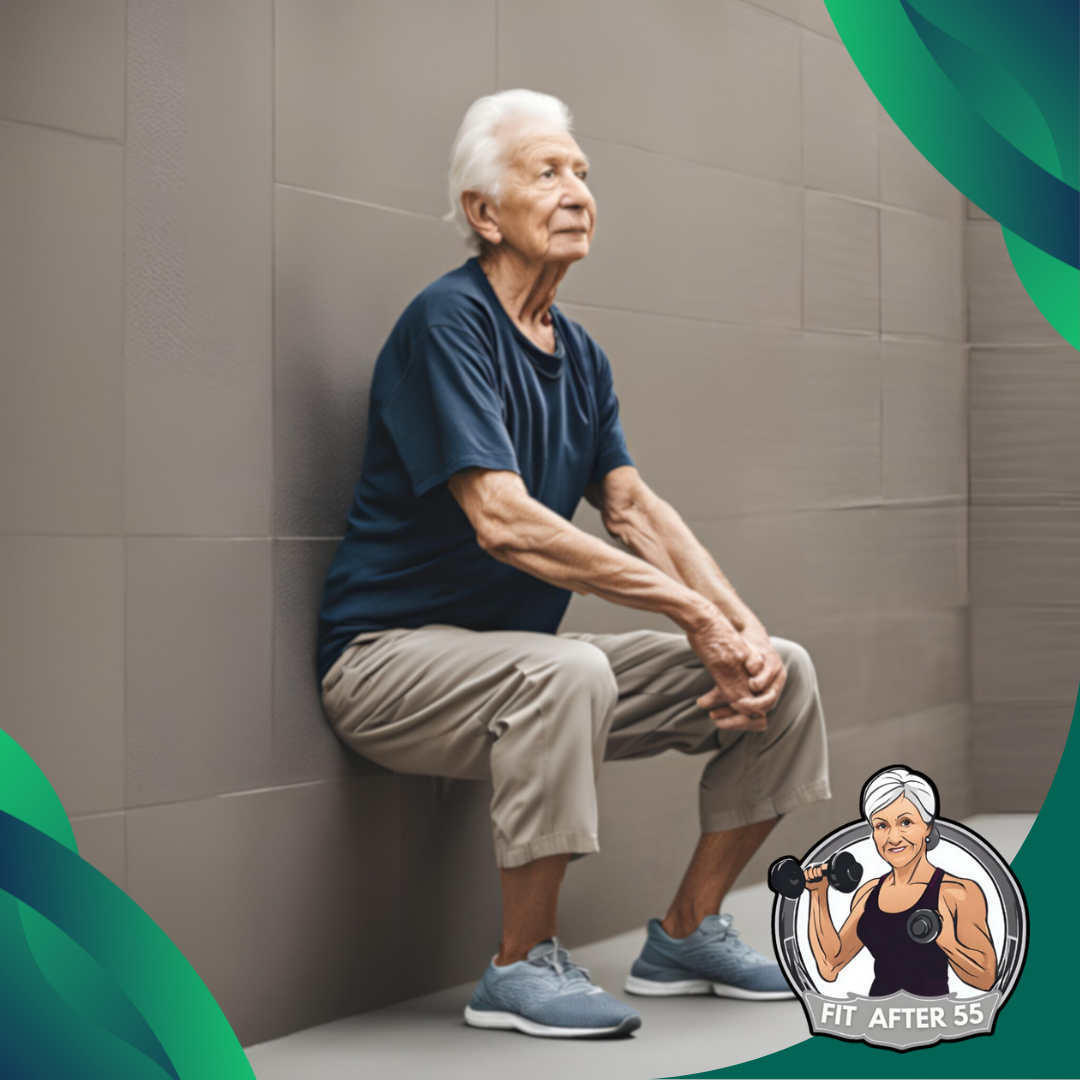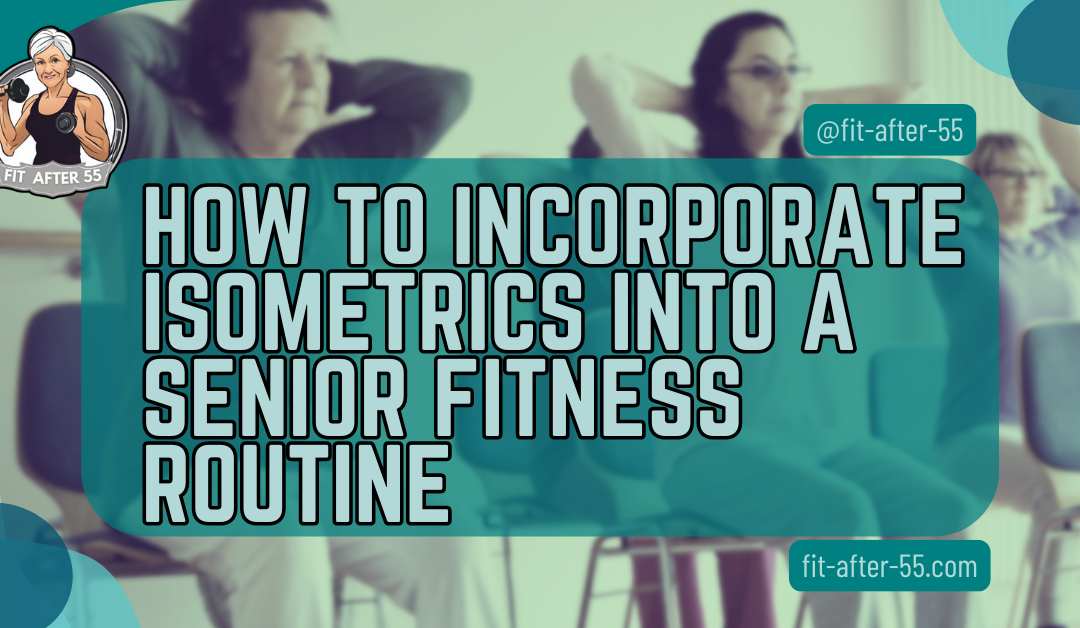How to Incorporate Isometrics into a Senior Fitness Routine: Gentle Strength Building for Older Adults
Are you looking for a way to boost your fitness routine without putting too much strain on your body? Isometric exercises might be just what you need. These exercises involve holding a position or contracting a muscle without moving. They’re great for seniors because they’re low-impact and can help build strength and stability.

Isometric exercises can be done anywhere, anytime. You don’t need fancy equipment or a gym membership. Isometric exercises can increase muscle strength, improve balance, and enhance joint stability. This makes them perfect for seniors who want to stay active and maintain their independence.
Adding isometrics to your workout routine is easy. You can start with simple exercises like wall sits or planks. As you get stronger, you can try more challenging moves. Remember to start slow and listen to your body. With regular practice, you’ll soon notice improvements in your strength and overall fitness.
Key Takeaways
- Isometric exercises are low-impact and can be done anywhere without special equipment
- These exercises can improve strength, balance, and joint stability for seniors
- Start with simple exercises and gradually increase difficulty as you get stronger

Understanding Isometrics
Isometric exercises are a type of strength training where you hold a position without moving. Your muscles work hard, but they don’t change length. These exercises can be great for seniors. They put less stress on your joints compared to other types of exercise. This makes them safer if you have joint problems.

You can do isometrics almost anywhere. No special equipment is needed. Isometric bicep curls are a good example. You simply hold a weight in place without lifting or lowering it. Another easy isometric exercise is the wall sit. You lean against a wall with your legs bent as if sitting in an invisible chair. Hold this position to work your leg muscles.
When doing isometrics, remember to breathe normally. Don’t hold your breath. Start with short holds of 10-15 seconds. As you get stronger, you can try holding for 30-60 seconds.
Isometrics can help improve your:
- Strength
- Balance
- Posture
- Muscle endurance
Remember to listen to your body. If something hurts, stop the exercise. It’s always a good idea to talk to your doctor before starting any new exercise program.

Benefits of Isometrics for Seniors
Isometric exercises offer many advantages for older adults. They can boost strength, improve balance, and support joint health without putting too much stress on the body.
Enhanced Muscle Strength
Isometric exercises can help seniors build strength without moving their joints. This is great for those who have trouble with regular workouts. You can do these exercises anywhere, anytime.
To start, try wall sits or planks. Hold each pose for 10-30 seconds. Do this 2-3 times a week. You’ll feel stronger in no time. As you get better, you can hold poses longer. Or try harder exercises. Always listen to your body and don’t push too hard.
Improved Balance and Stability
Better balance means fewer falls. Isometrics can help you stay steady on your feet. Try standing on one leg while holding onto a chair. Hold for 10 seconds, then switch legs. Do this daily to boost your balance.
Another good exercise is the heel raise. Stand tall and lift your heels off the ground. Hold for 5-10 seconds. This works your leg muscles and improves stability.
Joint Health and Mobility
Isometric exercises are gentle on your joints. They can help keep you moving without pain. For knee health, try isometric leg extensions. Sit in a chair and straighten one leg. Hold for 10 seconds, then switch legs. This strengthens your knees without straining them.
To help your shoulders, try wall angels. Stand with your back against a wall. Raise your arms in a “V” shape and hold. This improves shoulder mobility and posture. Remember to breathe normally during these exercises. Start slow and build up over time. You’ll soon feel more flexible and mobile in your daily life.
Safety Precautions and Considerations

Adding isometric exercises to your routine can be great, but it’s important to stay safe. Here are some key things to keep in mind as you get started.
Consulting with Healthcare Providers
Before you begin any new exercise program, it’s crucial to talk to your doctor. They know your health history and can give advice tailored to you. Ask about any health issues that might affect your ability to do isometric exercises. Your doctor can suggest safe ways to start and which moves to avoid.
If you have high blood pressure, heart problems, or joint issues, get specific guidance. Some isometric exercises might not be right for you. Remember, your doctor is there to help you stay healthy and active. Don’t be shy about asking questions or expressing concerns.
Recognizing Personal Limits
Listen to your body when doing isometric exercises. If something hurts, stop right away. Start slow and build up gradually. Begin with short holds of 5-10 seconds. As you get stronger, you can try longer holds.
Pay attention to how you feel during and after exercises. If you’re very sore or tired the next day, you might need to take it easier. Don’t push yourself too hard. It’s better to do less and stay safe than to overdo it and risk injury. Set realistic goals based on your current fitness level. Celebrate small wins as you progress.
Incorporating Rest and Recovery
Rest is just as important as exercise for seniors. Give your body time to recover between workouts. Try doing isometric exercises every other day at first. This gives your muscles time to rebuild and get stronger.
Make sure you’re getting enough sleep. Good sleep helps your body recover and reduces injury risk. Stay hydrated and eat a balanced diet to support your exercise routine. Proper nutrition helps with recovery.
If you feel extra tired or sore, take an extra rest day. It’s okay to be flexible with your routine. Remember, recovery time might increase as you age. Be patient with your body and give it the rest it needs.
Designing an Isometric Workout Plan

A well-designed isometric workout plan can help seniors build strength safely. It combines the right exercises, clear goals, and a balanced approach.
Setting Realistic Goals
Start by setting clear, achievable goals for your isometric workout plan. Think about what you want to improve, like balance or muscle strength. Write down your goals and be specific. For example, aim to hold a wall sit for 30 seconds by the end of the month. Or try to do ten isometric squeezes daily.
Keep track of your progress. Use a notebook or app to record your workouts. This helps you see improvements and stay motivated. Remember, small steps lead to big changes. Celebrate every bit of progress you make.
Selecting Appropriate Exercises
Choose isometric exercises that match your fitness level and goals. Start with basic moves and slowly add more challenging ones. Here are some good isometric exercises for seniors:
- Wall sits
- Plank holds
- Doorway chest presses
- Static lunges
- Isometric back planks
Pick exercises that target different muscle groups. This helps you build overall strength. Always focus on proper form to avoid injury. Ask a fitness expert or doctor if you’re not sure which exercises are right for you. They can help you choose safe, effective moves.
Integrating Isometric Exercises with Other Workouts
Mix isometric exercises with your regular fitness routine. This adds variety and boosts your overall strength. You can do isometrics on their own or as part of other workouts.
Try adding isometric holds to your usual exercises. For example, pause for a few seconds at the bottom of a squat. Or hold a bicep curl halfway through the movement.
You can also use isometrics as a warm-up or cool-down. This helps prepare your muscles for activity or helps them recover after a workout. Remember to give your muscles time to rest between isometric sessions. This helps prevent overuse and allows for proper recovery.
Essential Isometric Exercises for Seniors
Isometric exercises are great for seniors. They build strength without putting stress on joints. These exercises can be done almost anywhere and don’t need special equipment.

Wall Sits
Wall sits are a simple but effective isometric exercise. They work your leg muscles and core. To do a wall sit:
- Stand with your back against a wall.
- Slowly slide down until your thighs are parallel to the floor.
- Hold this position for 10-30 seconds.
- Slowly slide back up.
Start with shorter holds and work up to longer ones. You can do wall sits daily to build leg strength. If you have knee problems, don’t slide down as far. Stop at a point that’s comfortable for you.
Plank Holds
Planks are great for building core strength. They also work your arms and legs. Here’s how to do a plank:
- Start on your hands and knees.
- Lower your forearms to the floor.
- Extend your legs behind you.
- Hold your body in a straight line.
Try to hold for 10-30 seconds. Rest, then repeat. If a full plank is too hard, you can do it with your knees on the floor. Planks are low-impact and put less strain on your spine than many other core exercises.
Leg Lifts
Leg lifts help strengthen your lower abs and hip flexors. They’re easy to do and don’t require any equipment. To do leg lifts:
- Lie on your back with your legs straight.
- Slowly lift one leg about 6 inches off the floor.
- Hold for 5-10 seconds.
- Lower your leg and repeat with the other leg.
Start with five lifts per leg and work up to more. If lifting your leg is too hard, bend your knee slightly. You can do leg lifts while watching TV or listening to music. They’re a great way to add isometric exercises to your routine.
Monitoring Progress and Adapting the Routine

Keeping track of your isometric exercises and adjusting them as needed is key to seeing results. Regular check-ins help you stay on track and make smart changes to your workout.
Tracking Strength and Endurance
To monitor your progress, try these simple methods:
- Use a stopwatch to time how long you can hold each pose
- Keep a workout log to record your exercises and times
- Take photos of your form to spot improvements
You can also measure your isometric strength with special tools. A hand grip dynamometer checks your grip strength. For other muscle groups, try using a force gauge or strain gauge. Pay attention to how you feel during and after workouts. Are you less tired? Can you hold poses longer? These are good signs you’re getting stronger.
Adjusting Intensity and Duration
As you get stronger, you’ll need to make your workouts harder. Here are some ways to do that:
- Hold poses for longer periods
- Add more sets to each exercise
- Try more challenging positions
Start small. Add 5 seconds to your hold times or one extra set per week. This helps prevent injury and keeps you motivated. If an exercise feels too easy, try a harder version. For example, move from wall pushups to countertop pushups. Always listen to your body and stop if you feel pain.
Remember to rest between workouts. Your muscles need time to recover and grow stronger. If you’re feeling very tired, take an extra rest day or do a lighter workout.
Additional Tips for Success

Incorporating isometric exercises into your fitness routine can be very rewarding. These tips will help you get the most out of your workouts and stay healthy.
Staying Consistent
Set a regular schedule for your isometric exercises. Try to do them at the same time each day. This helps form a habit. Keep a workout log to track your progress. Write down which exercises you do and how long you hold each pose. This can be motivating when you see improvements.
Start small and build up gradually. Even a few minutes of isometrics daily can make a difference. As you get stronger, you can add more time or new exercises. Don’t get discouraged if you miss a day. Just get back on track the next day. Remember, consistency over time is key.
Staying Hydrated
Drink water before, during, and after your isometric workout. Even though you’re not moving much, your body still needs fluids. Keep a water bottle nearby during your exercises. Take sips between poses or sets.
Proper hydration helps your muscles work better and can prevent cramping. It’s especially important as you age. If plain water isn’t appealing, try adding a slice of lemon or cucumber. Herbal tea can also be a good option. Watch for signs of dehydration like dry mouth or dark urine. If you notice these, increase your fluid intake.
Getting Enough Nutrition
Eat a balanced diet to support your isometric exercises. Include plenty of protein to help build and maintain muscle. Good protein sources include lean meats, fish, eggs, and beans. If you’re vegetarian, try tofu or lentils.
Don’t forget about carbs and healthy fats. They provide energy for your workouts. Whole grains, fruits, and vegetables are great choices. Consider a post-workout snack to help with recovery. A banana with peanut butter or Greek yogurt with berries can be good options. If you’re unsure about your diet, talk to your doctor or a nutritionist. They can help you create a meal plan that fits your needs.
Fun Fact
Did you know that isometric exercises are one of the best workout routines for seniors? No equipment is required! You can do these exercises anywhere, anytime, without needing any special gear.
How To Incorporate Isometrics Into A Senior Fitness Routine: Your Ultimate Health Guide

Isometric exercises can be a great addition to your senior fitness routine. They help build strength without putting too much stress on your joints.
Start slow and listen to your body. Try adding a few isometric holds to your workouts each week. You might start with wall sits or planks. Remember to breathe normally during these exercises. Don’t hold your breath, as this can raise your blood pressure.
Always check with your doctor before starting any new exercise program. This is especially important if you have any health conditions or injuries. As you get stronger, you can increase the time you hold each position. You can also try more challenging exercises like dead hangs or isometric bicep curls.
By adding isometrics to your routine, you’re taking a great step toward improving your strength and balance. Keep at it, and you’ll likely see improvements in your daily activities, too. Stay consistent and patient. Results may take time, but the benefits to your health and fitness are worth the effort. Keep moving, and stay strong!
Ready to give isometric exercises a try? Share your experiences and inspire others to stay active and healthy. Let’s create a supportive community for seniors who want to improve their fitness.
Frequently Asked Questions

Isometric exercises can be a great addition to a senior fitness routine. They’re safe, effective, and can be done almost anywhere. Let’s explore some common questions about incorporating isometrics for older adults.
What are some safe isometric exercises for seniors starting their fitness journey?
Wall sits are a good starting point for seniors. Stand with your back against a wall and slowly slide down until your thighs are parallel to the ground. Hold this position. Planks are another safe option. Start on your forearms and toes, keeping your body straight. If that’s too challenging, you can do them from your knees instead.
How often should seniors perform isometric exercises?
Seniors can do isometric exercises 2-3 times a week. It’s important to give your muscles time to recover between sessions. Start with 1-2 exercises per session and gradually increase as you get stronger. Remember to listen to your body and not overdo it.
Can you recommend any isometric exercises specifically beneficial for individuals over 60?
The wall push is great for upper body strength. Stand facing a wall with your hands at shoulder height. Push against the wall as if trying to move it. For the lower body, try isometric squats. Lower yourself into a squat position and hold. This helps maintain leg strength and balance.
What's the ideal duration for seniors to hold isometric exercises?
For beginners, start with 10-15 second holds. As you build strength, you can gradually increase to 30 seconds. Always focus on proper form rather than duration. It’s better to hold for a shorter time with good form than longer with poor form.
Where can seniors find easy-to-follow isometric exercise tutorials?
Many fitness websites offer free tutorials. YouTube is also a great resource for visual demonstrations of isometric exercises. Your local senior center or community college might offer fitness classes that include isometric training. These can provide hands-on guidance.
What are some classic examples of isometric exercises that can be included in a senior's fitness routine?
Planks are a classic isometric exercise. They work multiple muscle groups and can be modified to suit different fitness levels. Dead hangs are another good option. Hang from a sturdy bar or doorframe for as long as it is comfortable. This helps improve grip strength and shoulder stability.

Stay Fit, Feel Fabulous!
Looking for fitness inspiration? Our Facebook page is packed with tips, tricks, and workout routines tailored for those 55 and over. Join our vibrant community and discover how to stay active, healthy, and happy.
Let’s get fit together!

